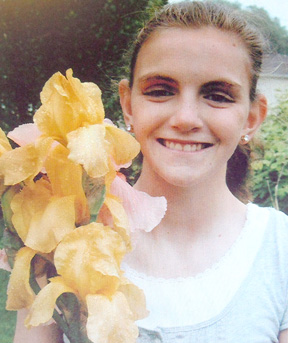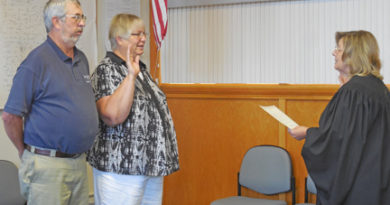To Mend My Broken Heart

For Kylea Hintz, an average junior high student who was getting ready for summer vacation, life can change at the drop of a hat. “If someone were to ask me what I was going to do for the summer of 2011,” she explains, “I would have said I really don’t know. I have no major plans. But, it is amazing how one day, or even 30 minutes, can change the rest of your life.”
Kylea, who was 13 years old at the time, found out two weeks before finishing the seventh grade that she had a coarctation of the aorta; not something most young teens would understand. “It means my aorta, which carries the main supply of blood to the body, was pinched,” she said, “and my doctor told me I needed heart surgery right away.”
Coarctation of the aorta is a congenital heart defect that happens when there is a narrowing of the aorta as it makes the turn to supply blood to the lower part of the body. The narrowing is usually located just after the takeoff of the left subclavian artery (the branch to the left arm). The left heart pump (ventricle) has to pump harder to force the blood to get through the narrowed area in order to supply the abdomen and legs with enough blood. With time the left ventricle muscle becomes thicker. The blood pressure gets higher, so has to push the blood across the narrowed area and as the blood squeezes through the obstructed area, it scatters under high pressure into strong jets; most of which move the blood forward, but others hit hard against the walls of the aorta. Since so much moving energy is wasted in trying to force the blood through, the pressure beyond the narrowed area itself will be low.
In youth, this action leads to high pressure in the arms and low pressure in the legs. High pressure in the arms transmits to high pressure to the arteries going to the brain and if this pressure goes untreated, stroke can occur. “The blood pressure in my arm was 156,” Kylea said, “and the pressure in my leg was only 86, which showed a big difference between the upper half of my body and the lower half.”
But getting the news about her heart wasn’t where her journey started. Kylea’s journey to the cardiologist started eight months earlier in the fall of 2010 with a sore wrist, hardly a clue that would eventually lead to a congenital heart defect. She complained to her mother that her left wrist hurt when she played volleyball. “We taped it and gave her Tylenol,” Ranae said, “and Kylea toughed it out until basketball started. Then she couldn’t take the pain anymore.”
An ensuing doctor’s appointment led Kylea to physical therapy for a month, but little improvement there prompted a visit to an orthopedic specialist. There she was diagnosed with Kienbock’s disease, a condition in which one of eight small carpal bones in the wrist loses its blood supply and begins to die. Interestingly enough, Kienbock’s disease is most common in men between the ages of 20 and 40, not 13-year-old girls starting their junior high sports careers. “They put me in a cast for two months and a brace after that,” Kylea said. “In March (2011) when we went back to the orthopedist, he said my case was strange and wanted me to see another doctor.”
In the meantime, Rick and Ranae appealed to the Shriners Hospital in Minneapolis where a pediatrician found a heart murmur and thyroid dysfunction. From there Kylea was sent to cardiologist Ameeta B. Martin of Lincoln who, after conducting an echocardiogram, determined Kylea’s pinched aorta. “Dr. Martin said it was a miracle that the pediatrician at Shriners Hospital even heard the murmur,” added Kylea. “With my hypothyroidism (underactive thyroid), the murmur was very quiet.”
On the first day of summer vacation, May 20, Dr. James M. Hammel of Children’s Hospital in Omaha, performed closed heart surgery on Kylea. “He told me closed heart surgery meant the place my heart needed to be fixed was on the outside and that he would go in through my back around my shoulder blade,” she explained and added that this condition, not normally seen in teens, is often caught and corrected in infants at birth. Dr. Hammel told her she could have been one of those seemingly healthy athletes who just drop dead from a heart attack and that if her condition had gone undetected or untreated, she quite possibly may have not lived to see her 20th birthday.
Kylea said at that point she was scared, but that the nurses were very kind and her family and friends threw her a pre-surgery party at the hotel to ease her mind. There was also a special prayer service at the Methodist church in Hebron where several friends and family members gathered. Kylea said the prayers were definitely felt and answered.
“The surgery lasted seven hours,” Kylea said, “but it felt like two seconds to me. My mom told me that watching me go down the hallway to surgery was the hardest thing she ever had to do.”
Kylea said her aorta had become completely blocked which Dr. Hammel discovered during surgery. “He said we were really lucky to have caught it when we did and that the only way blood was getting to the lower part of my body was through bypasses that my body had created on its own,” she said. “It was amazing to me that my body could do that.”
Dr. Hammel removed approximately two inches of her aorta and replaced it with artificial aorta. If the condition had been caught and corrected at birth, the surgeon would have cut out the obstruction and stretched the remaining aorta connecting it back together enabling the aorta to grow with the body. The artificial aorta cannot grow so at some point may need to be replaced if it cannot support the blood flow needed.
In all, Kylea stayed three days in ICU, one day on the recovery floor and one day in the Children’s Rainbow House before heading home. Following a slight setback due to dehydration on her third day home, Kylea began to heal and in three weeks went back to Dr. Martin for a check-up. Also during that time, the young teen needed to get a handle on her hypothyroidism and was scheduled to see an endocrinologist. “She, Dr. Cabrera, said my numbers were looking good now that I was taking levothyroxine, but if I didn’t grow in the next four months, I would need more testing,” Kylea explained.
And now that her heart and thyroid were stabilized, it was again time to concentrate on her wrist. “So we went back to Shriners Hospital where I had a great check-up,” she said. “I had twice the movement in my wrist than before and the doctor’s think that my problem was maybe tied to my heart and thyroid.”
A final echocardiogram on her heart a week after her visit to the Shriners Hospital showed minimal fluid on her heart and she was released to do as she pleased with some summer time limitations. “I couldn’t play ball or ride my horse at the fair, but after twelve weeks I had a sweet scar and a fixed heart.”
Today Kylea is nearing the end of a very productive and active eighth grade year and although she is well aware that her disease is genetic and may show its face again one day, she very much wants to be there for others who may suffer from the same problems. She shares her story “To Mend My Broken Heart,” through a scrapbook journal as a way of showing her appreciation for the special people in her life that supported her and her family through their difficult summer. “I hope the rest of my story continues to improve,” she concludes in her journal. “I know God was with me and that he has bigger plans for me. Mostly I want to be a support and resource to anyone who may have something like this affect them. I want everyone to know that your life can change in just minutes, so live every day like it’s your last.”



